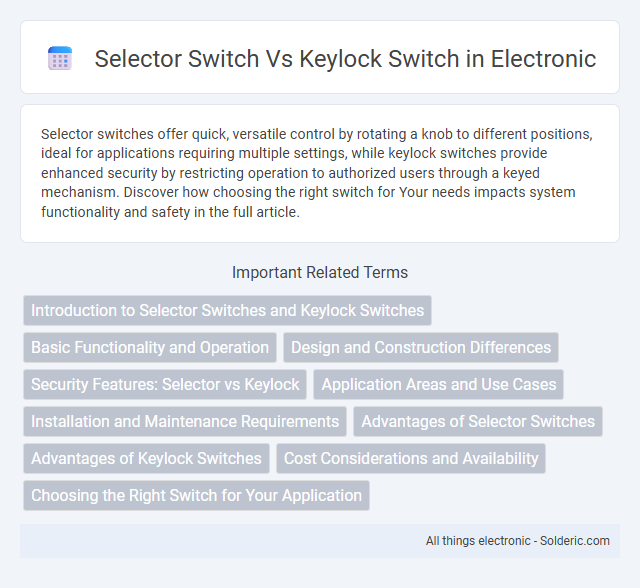Selector switches offer quick, versatile control by rotating a knob to different positions, ideal for applications requiring multiple settings, while keylock switches provide enhanced security by restricting operation to authorized users through a keyed mechanism. Discover how choosing the right switch for Your needs impacts system functionality and safety in the full article.
Comparison Table
| Feature | Selector Switch | Keylock Switch |
|---|---|---|
| Function | Allows selecting multiple electrical circuits or modes | Enables or disables device operation with a key for security |
| Operation Type | Rotary or toggle multi-position switch | Lockable switch operated by a removable key |
| Security | Low to none; mainly for switching modes | High; prevents unauthorized access or use |
| Applications | Control panels, machinery mode selection | Access control, safety locks, restricted operation |
| Cost | Generally lower cost | Higher due to key mechanism |
| Installation | Simple; standard switch panel mounting | Requires secure mounting with key retention |
| Durability | Standard mechanical durability | Enhanced due to locking mechanism |
Introduction to Selector Switches and Keylock Switches
Selector switches are rotary or toggle devices used to control electrical circuits by selecting different operational modes or functions, often found in industrial control panels and machinery. Keylock switches require a specific key to operate, providing an added layer of security to prevent unauthorized use or changes to critical settings. Understanding the differences between selector switches and keylock switches helps you choose the right control mechanism for your application's safety and functionality requirements.
Basic Functionality and Operation
Selector switches enable users to choose between multiple circuit options or control modes by rotating a knob, providing clear visual feedback on the selected position. Keylock switches require a physical key to operate, offering enhanced security by restricting access to authorized personnel only. Your choice depends on whether ease of operation or controlled access is the priority for your application.
Design and Construction Differences
Selector switches feature a rotary design with multiple positions allowing easy selection between different circuits, typically housed in a compact, durable plastic or metal casing suited for panel mounting. Keylock switches incorporate a built-in key mechanism that physically locks the switch in specific positions, enhancing security and preventing unauthorized operation, and are often constructed with robust metal components for increased tamper resistance. The keylock switch's design emphasizes controlled access, while the selector switch prioritizes versatile operation without security constraints.
Security Features: Selector vs Keylock
Selector switches provide basic security by limiting operational modes but can be easily bypassed without a key, making them suitable for general control applications rather than high-security environments. Keylock switches offer enhanced security by requiring a physical key to change positions, preventing unauthorized access and ensuring that only authorized personnel can operate or modify equipment settings. The keylock's mechanical lock mechanism significantly reduces the risk of tampering compared to selector switches, making it ideal for critical safety and security controls.
Application Areas and Use Cases
Selector switches are commonly used in industrial control panels, machinery, and automation systems where operators need to choose between multiple operating modes or functions quickly and efficiently. Keylock switches, on the other hand, are designed for security-sensitive applications such as access control, authorized equipment operation, and safety interlocks, ensuring only users with the correct key can activate or deactivate the device. Your choice between these switches depends on whether you prioritize ease of mode selection or secure, restricted access in your application.
Installation and Maintenance Requirements
Selector switches offer straightforward installation with standard panel mounting and simple wiring configurations, making them suitable for quick setups and routine maintenance. Keylock switches require secure installation involving lock cylinder integration and may need specialized tools or procedures for key management during maintenance. Maintenance of keylock switches often involves periodic key inspections and replacements to ensure security, whereas selector switches typically demand less frequent servicing focused on mechanical wear and electrical contact checks.
Advantages of Selector Switches
Selector switches offer enhanced versatility and ease of use, allowing you to quickly toggle between multiple circuit states with a simple rotary motion. Their design supports clear visual feedback and reliable operation in industrial control panels, reducing the chance of accidental activation. Selector switches typically require less maintenance and provide greater durability compared to keylock switches, making them ideal for frequent use environments.
Advantages of Keylock Switches
Keylock switches offer enhanced security by restricting operation access to authorized personnel only, reducing the risk of unauthorized or accidental activation. Their sturdy, tamper-resistant design ensures durability in industrial environments, providing reliable control in critical applications. Keylock switches are ideal for safety-critical systems where controlled access and operational integrity are paramount.
Cost Considerations and Availability
Selector switches generally offer lower cost options due to simpler construction and widespread availability in various sizes and configurations for industrial control panels. Keylock switches, featuring enhanced security with lock-and-key mechanisms, tend to be more expensive and less commonly stocked, requiring specialized suppliers or custom orders. Your choice depends on balancing budget constraints against the need for controlled access and secure operation.
Choosing the Right Switch for Your Application
Selector switches provide versatile control options with multiple positions, ideal for applications requiring easy mode selection or circuit changes. Keylock switches enhance security by restricting operation to authorized personnel, making them suitable for safety-critical or theft-sensitive environments. Assess application needs for accessibility versus security to determine the appropriate switch type.
Selector switch vs Keylock switch Infographic

 solderic.com
solderic.com